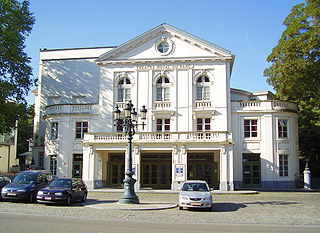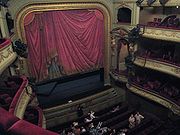
Théâtre Royal du Parc
Encyclopedia

Brussels
Brussels , officially the Brussels Region or Brussels-Capital Region , is the capital of Belgium and the de facto capital of the European Union...
, on the edge of the Parc de Bruxelles facing the Federal Parliament
Belgian Federal Parliament
The Belgian Federal Parliament is a bicameral parliament. It consists of the Chamber of Representatives and the Senate . It sits in the Palace of the Nation .- Chamber of Representatives :...
. Its nearest Metro
Brussels Metro
The Brussels Metro is a rapid transit system serving a large part of the Brussels-Capital Region of Belgium. It consists of a network with four metro line services with some shared sections. The metro has 49.9 km of network and 59 stations...
stations are Arts-Loi
Arts-Loi/Kunst-Wet metro station
Arts-Loi/Kunst-Wet is a Brussels metro station in the City of Brussels, Brussels. It is the only station in the metro network where all four lines meet. It is located under the intersection of "Rue de la Loi/Wetstraat" and "Avenue des Arts/Kunstlaan", the latter street being part of the "inner...
and Park.

History
Built in 1782 to plans by the architect Louis MontoyerLouis Montoyer
Louis Montoyer was an 18th century Belgian-Austrian architect, principally active in Brussels and Vienna.-Life:...
, the Théâtre du Parc was at first an annexe to the Théâtre de la Monnaie
La Monnaie
Le Théâtre Royal de la Monnaie , or the Koninklijke Muntschouwburg is a theatre in Brussels, Belgium....
: the brothers Alexandre
Alexandre Bultos
Alexandre Bultos was a Belgian comic-actor and theatre director.-Life:The seventh child of Pierre-François Bultos and his wife Marie-Josèphe Lambert, wine merchants and hotelliers, Alexandre made his stage debut in December 1761 aged 12, in La Servante maîtresse by Pierre Baurans, after the work...
and Herman Bultos
Herman Bultos
Herman Bultos was an 18th century Belgian wine merchant and theatre director.-Life:...
exploited the two theatres at the same time, with the Parc used for plays featuring young actors, as a sort of drama school for La Monnaie. It was closed in 1807 by Napoleon's decree on the theatres
Decree on the theatres
On 10 thermidor year 15 , Napoleon I of France signed a decree reducing the number of theatres in Paris to eight, giving the force of law to a decree of the interior minister of 25 April that same year. This measure cut short an expansion in theatres.Following is a list of the theatres that...
, but re-opened in 1814 and was occupied by a British company for a year then a Dutch company for a few months.
From 1819, the City of Brussels, owner of these two "Royal Theatres", granted a concession to one director after another. The company and repertoire were identical yet distinct, with the Théâtre du Parc specialising in vaudeville
Vaudeville
Vaudeville was a theatrical genre of variety entertainment in the United States and Canada from the early 1880s until the early 1930s. Each performance was made up of a series of separate, unrelated acts grouped together on a common bill...
and théâtre de boulevard.
From 1850 to 1854, the Parc hosted Dutch productions, then specialised in operetta and opéra-comique
Opéra-Comique
The Opéra-Comique is a Parisian opera company, which was founded around 1714 by some of the popular theatres of the Parisian fairs. In 1762 the company was merged with, and for a time took the name of its chief rival the Comédie-Italienne at the Hôtel de Bourgogne, and was also called the...
, and finally (from 1869) in comedies. During the First World War both theatres were requisitioned and the Parc became a playhouse for the German garrison. Returning to Francophone theatre in 1919, it put on classic pieces featuring Belgian actors. Its present director is Yves Larec.

